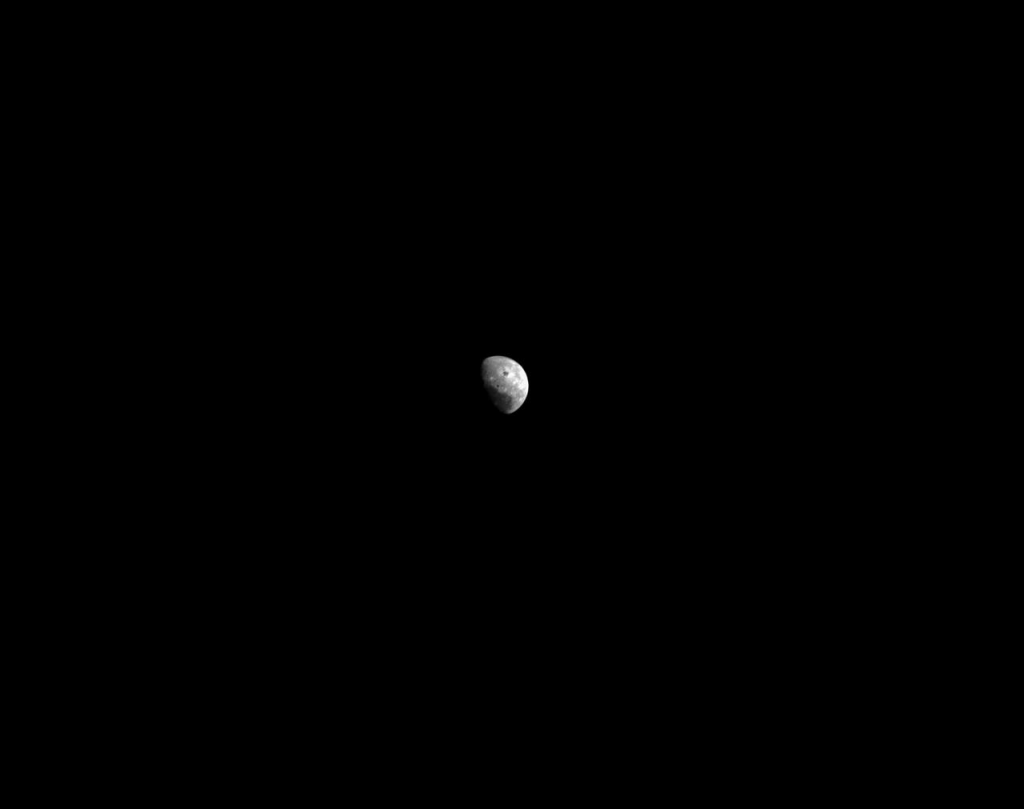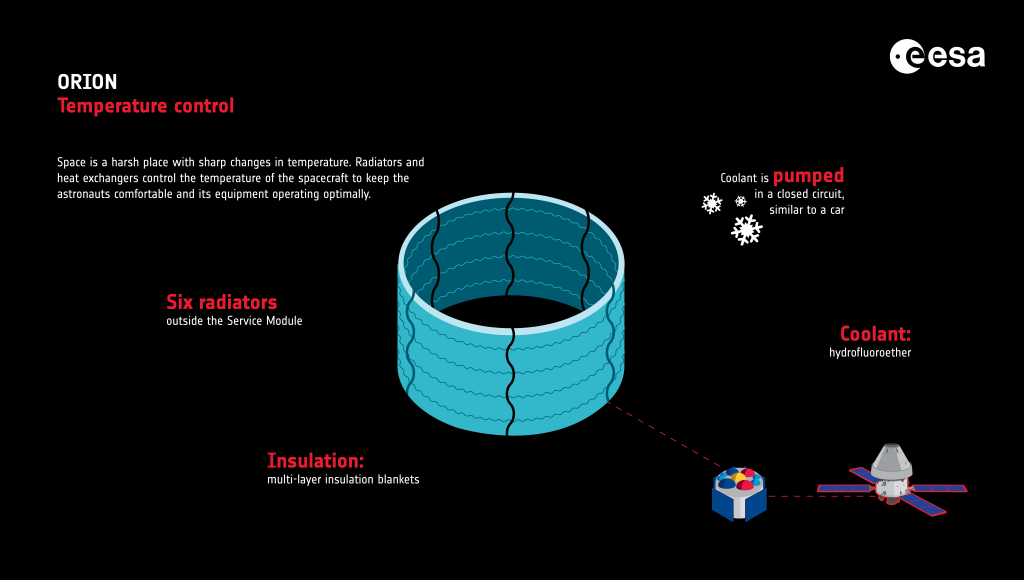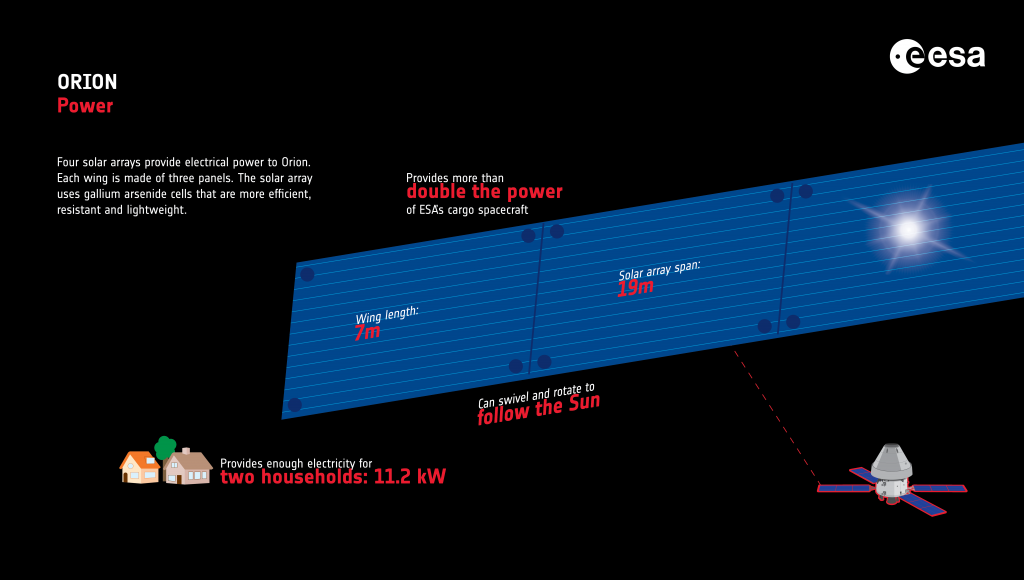After its launch on November 16, NASA’s Orion spacecraft has been heading toward the Moon on a 25-day mission. Orion was launched by the NASA Space Launch System (SLS) rocket at 7:47 CET (06:47 GMT) from launchpad 39B at NASA’s Kennedy Space Center in Florida, USA.
The uncrewed mission to learn as much as possible about Orion and its European Service Module’s performance. The primary objectives are to demonstrate Orion’s heat shield on reentry, demonstrate operations and facilities during all mission phases, and retrieve the spacecraft after splashdown.
Flight controllers in the Mission Control Center at NASA’s Johnson Space Center in Houston, USA, completed the first of five outbound trajectory correction burns before arriving at the Moon by instructing the European-built service module’s main engine to fire as planned at 15:32 CET (14:32 GMT). The burn tested Orion’s main engine for the first time and adjusted the spacecraft’s course toward the Moon.
Flight controllers performed a modal survey, a test to verify that the models and simulations used to design Orion’s solar array wings accurately reflect the motion that is occurring in flight. This was accomplished by firing Orion’s reaction control system thrusters and observing how the solar array wings react to that specific firing sequence. Engineers also calibrated the optical navigation system and gathered imagery using the spacecraft’s cameras. Orion has multiple cameras for engineering purposes as well as sharing the progress of the mission with the public.
Flight controllers moved each of the four solar arrays to a different position as the Integrated Communications Officer, or INCO, tested the WiFi transfer rate between the camera on the tip of the solar array panels and the camera controller. The goal was to determine the best position to most efficiently transfer images.
Flight day 2
The European Service Module performed its second outbound trajectory burn at 12:32 CET (11:32 GMT) using the auxiliary thrusters, which are used for most trajectory correction burns.
Teams also collected additional images with the optical navigation camera.

Flight day 3
On the third day of its Artemis I journey, Orion reached half way to the Moon.
“Today, we met to review the Orion spacecraft performance, and it is exceeding performance expectations.” said NASA’s Mike Sarafin, Artemis I mission manager.
Flight controllers used Orion’s cameras to inspect the crew module thermal protection system and the European Service Module, the first of two planned external evaluations for the spacecraft. Teams conducted this survey early in the mission to provide detailed images of the spacecraft’s external surfaces after it has flown through the portion of Earth’s orbit where there is the most space debris. The second inspection will be done on the return flight to Earth to assess the condition of the spacecraft several before reentry. During both inspections, the Integrated Communications Officer, or INCO, commands cameras on the four solar array wings to take still images of the entire spacecraft, allowing experts to pinpoint any micrometeoroid or orbital debris strikes. The team in mission control reviews the imagery.
Over the past few days, a team assessed anomalous star tracker data that correlated with thruster firings. Star trackers are sensitive cameras that take pictures of the star field around Orion. By comparing the pictures to its built-in map of stars, the star tracker can determine which way Orion is oriented. Teams now understand the readings and there are no operational changes.
Flight day 4
On 19 November, the Mission Management Team polled “go” for Orion’s outbound powered flyby past the Moon. NASA will cover the flyby live on NASA TV. The burn is planned for 13:44 CET (12:44 GMT). Orion will lose communication with Earth as it passes behind the Moon from 13:25 to 13:59 CET (12:25–12:59 GMT), making its closest approach of approximately 120 km from the surface at 13:57 CET (12:57 GMT).
The Emergency, Environmental, and Consumables Manager, or EECOM, tested the European Service Module’s radiator system. Two radiator loops on the spacecraft’s European Service Module help expel excess heat generated by different systems throughout the flight. Flight controllers are testing sensors that maintain the coolant flow in the radiator loops, switching between different modes of operation and monitoring performance. During speed mode, the coolant pumps operate at a constant rate. This is the primary mode used during Artemis I. Flow control mode adjusts the pump speed as needed to maintain a constant flow through the system. The flight test objective is to monitor system performance and the accuracy of flow sensors to characterize the stability of this mode of operation. Each loop is monitored in flow control mode for 72 hours to provide sufficient data for use on future missions.

As part of planned testing throughout the mission, the guidance, navigation, and control officer, also known as GNC, performed the first of several tests of the star trackers that support Orion’s navigation system. Star trackers are a navigation tool that measure the positions of stars to help the spacecraft determine its orientation. In previous flight days, engineers evaluated initial data to understand star tracker readings correlated to thruster firings.
Engineers hope to characterize the alignment between the star trackers that are part of the guidance, navigation and control system and the Orion inertial measurements units, by exposing different areas of the spacecraft to the Sun and activating the star trackers in different thermal states.
Flight day 5
Overnight, engineers in mission control uplinked large data files to Orion to better understand how much time it takes for the spacecraft to receive large files. Flight controllers in the White Flight Control Room at NASA’s Johnson Space Center in Houston captured more images of the Moon using the optical navigation camera. Gathering imagery of the Earth and the Moon at different phases and distances will provide better data to certify how well it can be used to determine location for future missions under different lighting conditions.
Orion completed its third outbound trajectory correction burn at 12:12 CET (11:12 GMT), firing the auxiliary thruster engines for a duration of 6 seconds at a rate of 1 m/s to accelerate Orion and adjust the spacecraft’s path while enroute to the Moon. The amount of speed change determines which of Orion’s service module engines – reaction control, auxiliary, or orbital manoeuvring system – to use for a particular manoeuvre.
The spacecraft entered into the lunar sphere of influence at 20:09 CET (19:09 GMT), making the Moon, instead of Earth, the main gravitational force acting on the spacecraft.
The European Service Module conducted the fourth outbound trajectory correction burn in advance of the outbound powered flyby burn.
Mission managers currently have two active anomaly resolution teams. Anomaly resolution teams are a standard part of managing the mission by pulling together a team of technical experts to focus on a specific issue by examining data to understand the implications in a particular system. Activating a separate team for this work enables engineers and flight controllers to continue focusing on commanding and monitoring the spacecraft and assessing the progress of the flight test.
One team is currently looking at the star tracker system to understand a number of faults in the random access memory, which have been successfully recovered with power cycles.

A second team is analysing a few instances in which one of eight units located in the service module that provides solar array power to the crew module, called a power conditioning and distribution unit umbilical latching current limiter, opened without a command. The umbilical was successfully commanded closed each time and there was no loss of power flowing to avionics on the spacecraft. Both systems are currently functioning as required, and there are no mission impacts related to these efforts. Analysing the data for these systems and understanding their behaviour during an active flight test while the hardware is in the deep space environment will improve mission operations on Artemis I and future missions.


 Automated Transfer Vehicle page
Automated Transfer Vehicle page ATV blog archive
ATV blog archive
 NASA Orion page
NASA Orion page NASA Artemis
NASA Artemis Airbus Orion page
Airbus Orion page
Discussion: 2 comments
Brilliant!! To the Moon and beyond!!
Amazing article. I will definitely recommend my students this site. Education is the key for success.